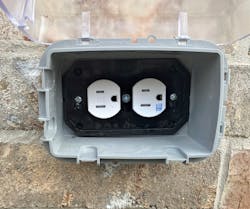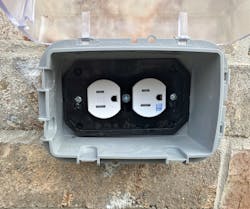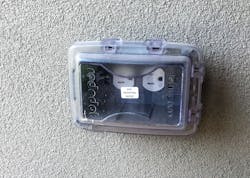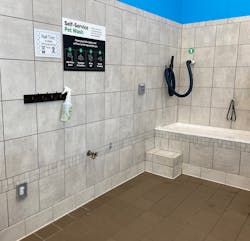Receptacle Deterioration Issues in Wet or Damp Locations
I remember working on a residential remodel project, troubleshooting a front porch electrical outlet that was not working. I first tested the receptacle to make sure there was no electricity present. Once verified, I removed the cover. As I began to remove the 6/32 screws holding the receptacle to the metal box, the screws broke. I received a bigger surprise when I began to remove the receptacle from the box. It was split into two pieces, and the back piece remained in the box. At this point, I decided to again test for the presence of electricity. To my astonishment, the remaining part of the receptacle in the box was indeed energized. Perplexed, I wondered why this receptacle had deteriorated in such a fashion. Little did I know that the electrical industry was already aware of these problems and bringing a solution to market.
The weather-resistant (WR) receptacle was first required in the 2008 edition of the National Electrical Code (NEC). Prior to it being published, complaints had been submitted to manufacturers and proposals submitted to NEC Code-Making Panels (CMPs) regarding receptacle failures in outdoor damp and wet locations. Thus, precautions needed to be taken when installing receptacles in indoor and outdoor damp or wet locations.
The current edition of the NEC requires all 15A and 20A, 125V and 250V nonlocking-type receptacles installed in damp or wet locations to be of the listed WR type (Photo 1).
Notice I didn’t say weatherproof type, but you’ll hear that inaccurate terminology used in the industry.
WR receptacles installed outdoors in wet and damp locations are subject to more demanding temperature variations, direct sunlight (UV rays), and possible mechanical abuse. WR receptacles are specifically designed to withstand these harsh environments and conditions. Several manufacturers have produced these receptacles with a “WR” designation on the face, readily identifying it as the WR type (although this is not a Code requirement).
Examples of outdoor damp locations include partially protected locations, such as under canopies, open-roofed porches, etc. Who determines if an area is a damp or wet location? That determination is made by the authority having jurisdiction (AHJ), which is a defined term in Art. 100 of the NEC. A receptacle installed in such a location will not be directly subjected to a beating rain or runoff.
A receptacle installed outdoors in a damp location is required to have an enclosure for the receptacle that is weatherproof when the receptacle is covered (attachment plug cap may not be inserted and receptacle’s cover is closed).
An installation suitable for wet locations is also suitable for damp locations. Examples of a wet location include locations subject to direct saturation with water or other liquids (such as vehicle washing areas) and in unprotected locations exposed to weather (such as outside a dwelling unit on an outside brick wall). Some indoor locations may also call for the installation of WR receptacles (Photo 2).
Why get hung up on the use of “weather resistant” versus the term “weatherproof?” Because they are different terms with different meanings. Weatherproof is defined in Art. 100 as being so constructed or protected that exposure to the weather will not interfere with successful operation. Rainproof, raintight, or watertight equipment can fulfill the requirements for weatherproof where varying weather conditions other than wetness (snow, ice, dust, temperature extremes, etc.) are not a factor. These terms are also defined in Art. 100. The WR receptacle will still get wet and be exposed to deterioration, but manufacturers have made them more durable to operate in these environments. One way is to add specific chemicals during the molding process that make the plastic more resistant to UV rays from the sun.
One manufacturer describes a WR receptacle device as having nickel-plated contacts and mounting straps to prevent corrosion. These receptacles are also shipped with stainless steel mounting screws, and feature enhanced nylon and corrosion-resistant metal components to make them extra durable.
No one should have to face the dilemma of troubleshooting a receptacle and encountering the problem I described in the opening paragraph. Unfortunately, installations like this still exist because they were installed legally prior to the creation of WR receptacles.
Take care when you are troubleshooting these receptacles. Always turn off the electricity in case the receptacle has deteriorated and testing does not sense the presence of electricity.
Joseph Wages, Jr., is the digital education director at IAEI. Previously, he held the positions of technical advisor, education, codes and standards and seminar coordinator at IAEI. He represents IAEI on NFPA’s NEC Code-Making Panel No. 2 for the 2020 and 2023 Code cycles. He previously represented IAEI on NFPA’s NEC Code-Making Panel No. 3 for the 2014 and 2017 NEC. He serves on the Underwriters Laboratories (UL) Electrical Council and on several UL Technical Standard Panels. He can be reached at [email protected].
About the Author
Joseph Wages, Jr.
Joseph Wages, Jr., is the director of education with IAEI. Previously, he held the positions of technical advisor, education, codes and standards and seminar coordinator at IAEI. He represents IAEI on NFPA’s NEC Code Making Panel-14 for the 2026 NEC. He previously represented IAEI on NFPA’s NEC Code Making Panel-2 for the 2020 and 2023 NEC code cycles and NFPA’s NEC Code Making Panel-3 for the 2014 and 2017 NEC.
He serves on the Underwriters Laboratories (UL) Electrical Council and on several UL Technical Standard Panels. Joseph continues to hold state electrical licenses and several IAEI and ICC building related certifications. Joseph can be reached at [email protected].



